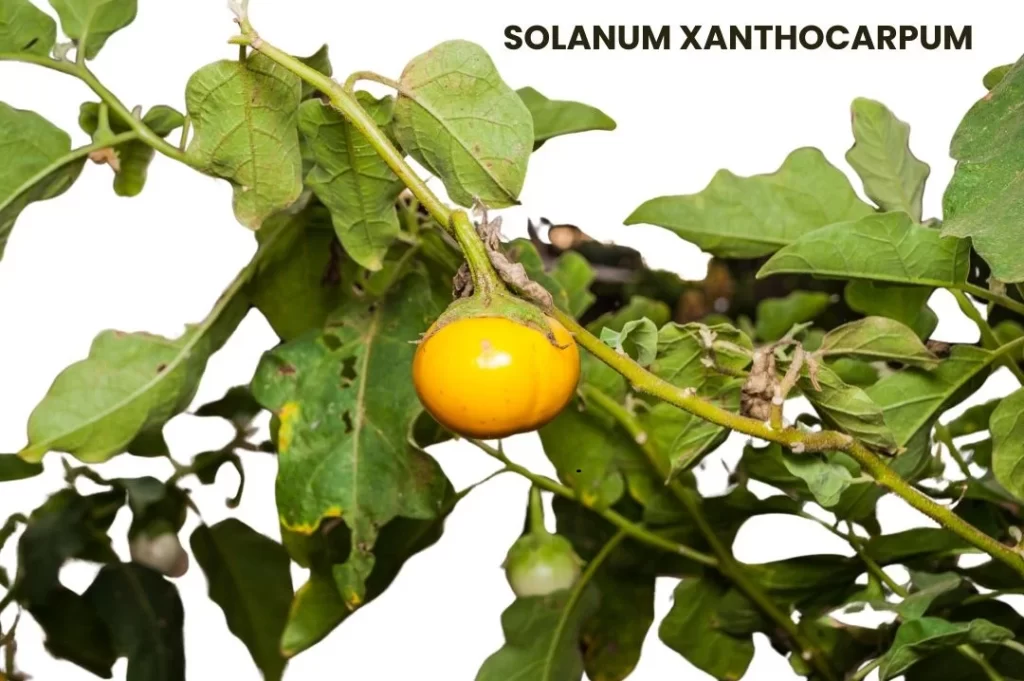Solanum xanthocarpum, commonly known as Kantikari, is a significant medicinal plant in the Solanaceae family.
It is widely used in traditional Ayurvedic medicine for its extensive therapeutic properties, particularly in treating respiratory and urinary disorders.

SOURCE INFORMATION
Common Names: Kantikari, Nidigdhika, Katele, Bhuringni, Warumlea, Kandan-kattiri, Pinna-mulaka
Scientific Classification
- Kingdom: Plantae
- Clade: Angiosperms
- Clade: Eudicots
- Order: Solanales
- Family: Solanaceae
- Genus: Solanum
- Species: S. xanthocarpum
Origin and Historical Facts
- Native Region: Solanum xanthocarpum is native to the Indian subcontinent and can be found in tropical and subtropical regions.
- Historical Usage: The plant has been used for centuries in Ayurvedic medicine.
- It is known for its effectiveness in treating respiratory conditions, fever, and urinary issues.
- Additionally, it has been recognized for its role in preventing smallpox and other infectious diseases.
Active Constituents
Solanum xanthocarpum contains several bioactive compounds, including:
- Alkaloids: Solasodine and solamargine, which have anti-inflammatory and antimicrobial properties.
- Steroidal Saponins: Contribute to the plant’s expectorant and diuretic effects.
- Flavonoids: Provide antioxidant benefits.
- Glycoalkaloids: Known for their therapeutic effects in respiratory and urinary disorders.
KEY CHARACTERISTICS
- Antitussive: Relieves cough.
- Expectorant: Helps expel mucus from the respiratory tract.
- Diuretic: Promotes urine production.
- Anti-inflammatory: Reduces inflammation.
- Antimicrobial: Fights infections.
DETAILED ORGAN SYMPTOMS
RESPIRATORY SYSTEM
- Hoarseness with Cough: Effective in treating hoarseness accompanied by a persistent cough.
- Bronchitis: Provides relief from bronchial inflammation and mucus buildup.
- Pneumonia and Broncho-pneumonia: Aids in managing the symptoms and inflammation associated with these conditions.
- Asthma: Acts as a bronchodilator, reducing the severity of asthma attacks.
FEVER
- Catarrhal Fever: Treats fever associated with excessive mucus production and respiratory infection.
- Thirst and Aversion to Food: Manages fever symptoms that include intense thirst and loss of appetite.
- Burning Sensation and Pain: Relieves the generalized burning sensation and pain often experienced during fever.
URINARY SYSTEM
- Stricture: Helps in managing the narrowing of the urinary tract.
- Retention or Suppression of Urine: Effective in treating conditions where there is difficulty in urination or complete suppression.
- Stone: Aids in the dissolution and expulsion of urinary stones.
MODALITIES
- Aggravation: Symptoms worsen in cold weather and during periods of physical exertion.
- Amelioration: Symptoms improve with rest and warmth.
WHAT ARE MODALITIES IN HOMOEOPATHY?
RELATIONSHIP WITH OTHER DRUGS
- Complementary: Works well in conjunction with other respiratory and diuretic remedies.
- Incompatible: There are no significant incompatibilities noted, but it is advisable to consult a healthcare provider when combining with other treatments.
DOSE
- Mother Tincture: Used for general and acute symptoms.
- Potency: Recommended potencies include 2x and 3x for chronic conditions and specific symptoms.
Frequently Asked Questions
What is Solanum xanthocarpum used for?
- Solanum xanthocarpum is primarily used for treating respiratory conditions like hoarseness, cough, bronchitis, pneumonia, and asthma.
- It is also effective in managing urinary disorders, fever, and preventing smallpox.
How does Solanum xanthocarpum help in respiratory conditions?
- The plant contains expectorant and bronchodilator properties, which help in clearing mucus from the respiratory tract and easing breathing.
Can Solanum xanthocarpum be used for urinary problems?
- Yes, it is effective in treating urinary retention, suppression, stricture, and stones due to its diuretic properties.
What are the side effects of Solanum xanthocarpum?
- Generally, it is well-tolerated, but overuse may cause gastrointestinal disturbances or allergic reactions in some individuals.
What is the recommended dosage for chronic conditions?
- For chronic conditions, potencies of 2x and 3x are recommended, depending on the severity and specific symptoms.
Glossary of Difficult Words
- Aphonia: Loss of voice.
- Broncho-pneumonia: A type of pneumonia that affects patches throughout both lungs.
- Catarrhal Fever: Fever accompanied by inflammation of the mucous membranes.
- Stricture: Abnormal narrowing of a bodily passage.
- Retention of Urine: Inability to empty the bladder completely.
- Suppression of Urine: Reduced production of urine by the kidneys.
- Antitussive: Medication that suppresses coughing.
- Expectorant: A medicine that promotes the secretion of sputum by the air passages, used to treat coughs.
This detailed source information provides a comprehensive overview of Solanum xanthocarpum, its medicinal properties, and therapeutic applications.
If you have any further questions or need additional information, feel free to ask!
